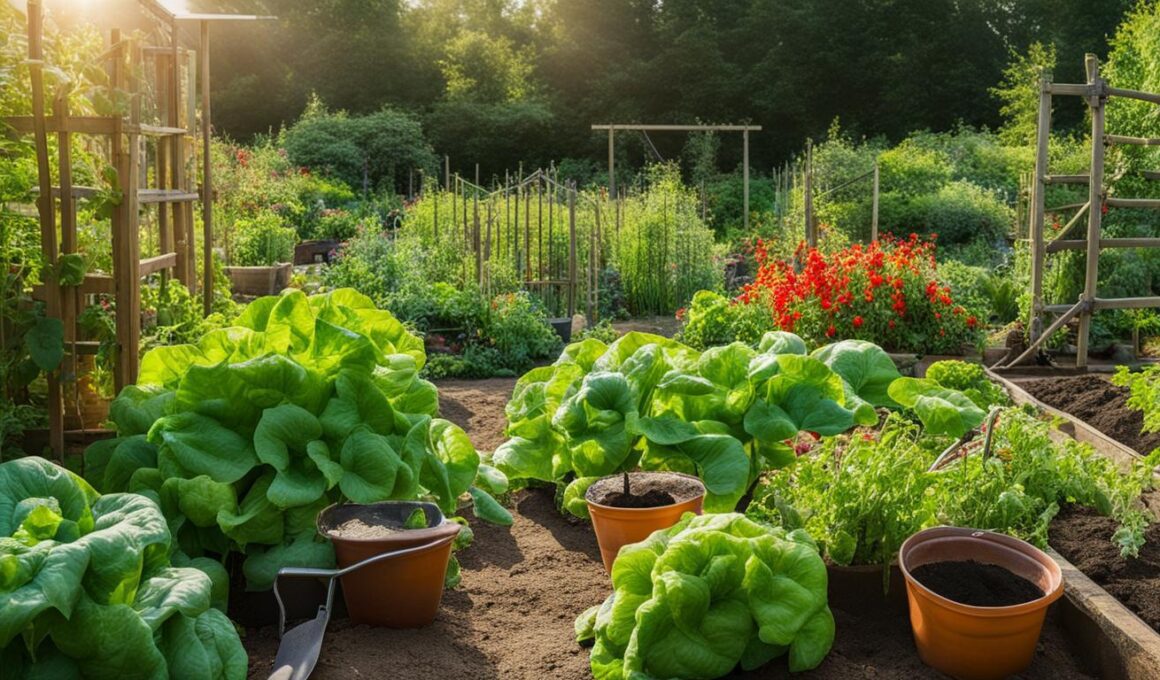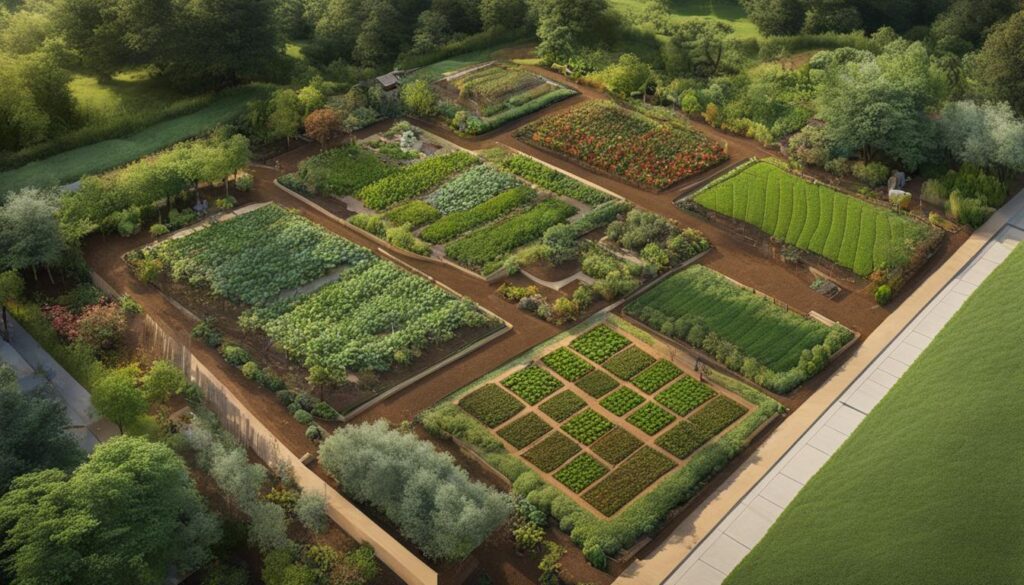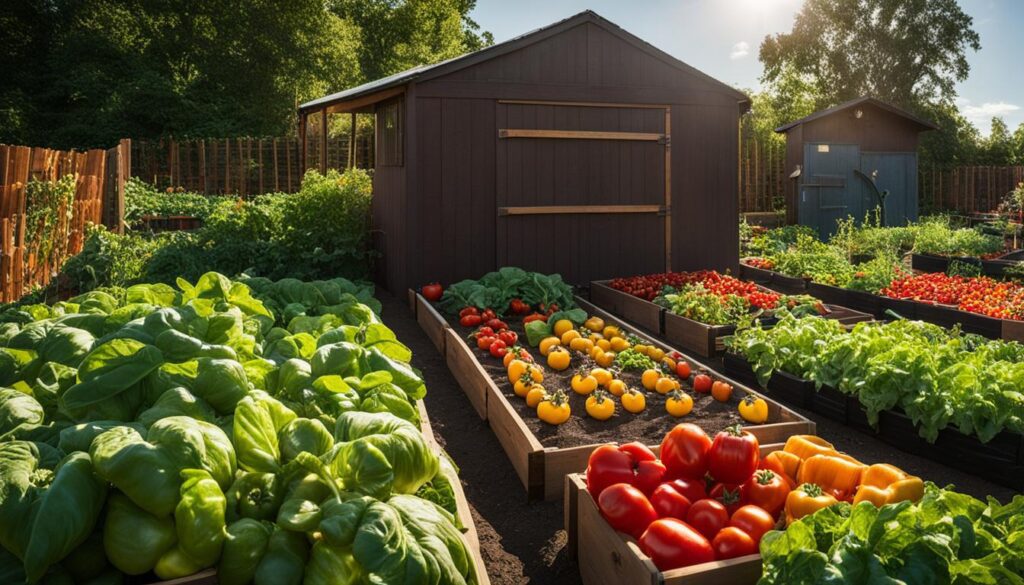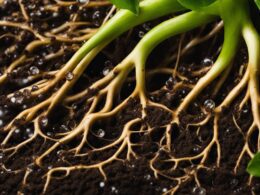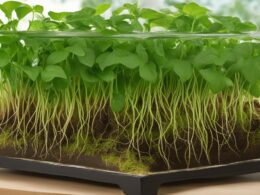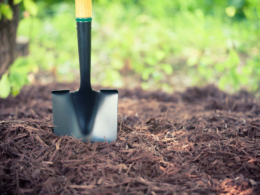Starting a vegetable garden can be a rewarding and cost-effective way to enjoy fresh and healthy produce. To ensure a successful harvest, it’s important to have the right tools, knowledge, and resources. This guide will provide you with all the essential must haves for a thriving vegetable garden.
Key Takeaways:
- Choose a sunny location with well-drained soil for your vegetable garden.
- Start with a manageable garden size and gradually expand as you gain experience.
- Select easy-to-grow vegetables that suit your preferences and local climate.
- Proper timing and organization are crucial when planting your vegetables for optimal growth.
- Maintain your vegetable garden by watering consistently, mulching, and practicing pest control.
Picking the Perfect Location for Your Vegetable Garden
Choosing the right location for your vegetable garden is essential for the success of your plants. Here are some important factors to consider:
1. Sunlight
Your vegetables need ample sunlight to grow and thrive. Make sure to select a spot that receives at least 6-8 hours of direct sunlight daily. Observe your garden throughout the day to determine the areas with the most sun exposure.
2. Soil Quality
Healthy soil is the foundation of a flourishing vegetable garden. Look for well-drained soil that is rich in organic matter. Consider conducting a soil test to assess its pH level and nutrient composition. Amend the soil as needed to create the optimal growing environment for your plants.
3. Wind and Foot Traffic
Avoid areas in your yard that are prone to strong winds, as this can damage or uproot your vegetables. Similarly, choose a location away from heavy foot traffic to prevent any accidental trampling of your plants. A peaceful and protected spot will provide the ideal growing conditions for your vegetable garden.
By carefully selecting the perfect location for your vegetable garden, you are setting the stage for a bountiful harvest. Remember to provide your plants with adequate sunlight, nutrient-rich soil, and protection from wind and foot traffic. With these considerations in mind, your vegetable garden will thrive, and you’ll enjoy fresh, homegrown produce throughout the growing season.
Selecting the Right Size for Your Vegetable Garden
When it comes to starting a vegetable garden, selecting the right size for your plot is essential for a successful and manageable gardening experience. Whether you are a beginner or an experienced gardener, choosing the appropriate garden size will help you maximize your space and yield a bountiful harvest. Here are some considerations to keep in mind when determining the size of your vegetable garden.
1. Start Small
For beginners, it’s recommended to start with a smaller garden size to avoid feeling overwhelmed. A 10′ x 10′ plot is a manageable size that allows you to grow a variety of vegetables without taking up too much space. Starting small also gives you the opportunity to learn and adjust your gardening techniques as you gain experience.
2. Consider Raised Beds
Using raised beds is a popular option for vegetable gardens as they offer several advantages. Raised beds provide better control over soil quality and drainage, especially in areas with poor soil conditions. For raised beds, a 4′ x 4′ or 4′ x 8′ size is commonly used. These dimensions allow easy access to plants from all sides and minimize the need for excessive bending or stretching.
3. Plan for Pathways and Accessibility
Regardless of the garden size or type, it’s important to leave enough space for pathways and easy access to your plants. This allows you to move around the garden comfortably for planting, maintenance, and harvesting. Plan your garden layout to ensure there is sufficient room between rows and beds, considering the size of the mature plants and any tools or equipment you may need to use.
Choosing the Best Vegetables for Your Garden
The success of your vegetable garden depends on choosing the right vegetables to grow. As a beginner, it’s important to start with varieties that are easy to grow and have a high chance of success. Here are some top recommendations:
- Lettuce: A fast-growing, leafy green that can be harvested throughout the growing season. Choose from a variety of types, such as romaine, butterhead, or loose-leaf.
- Green beans: These are vigorous climbers that produce an abundant crop. Choose bush beans for smaller gardens or pole beans for vertical growing.
- Radishes: A quick-growing root vegetable that adds a peppery crunch to salads. They can be harvested in as little as 3-4 weeks after planting.
- Tomatoes: This popular garden staple comes in many varieties, from cherry to beefsteak. They require support and regular pruning for optimal growth.
- Zucchini: A prolific summer squash that can provide an abundance of fruit. Choose compact varieties for smaller spaces.
“The glory of gardening: hands in the dirt, head in the sun, heart with nature. To nurture a garden is to feed not just the body, but the soul.” – Alfred Austin
Consider your family’s preferences when choosing vegetables. If you love salads, prioritize lettuce and other leafy greens. If you enjoy cooking, herbs like basil, thyme, and rosemary are great options. Take into account the climate and growing conditions of your area. Some vegetables thrive in cooler temperatures, while others require more heat and sunlight.
Research and Recommendations
For specific recommendations tailored to your region, consult your state’s Cooperative Extension Service. They can provide valuable information on which vegetables grow best in your area and when to plant them. Additionally, they can offer guidance on pest control, soil amendments, and other important aspects of vegetable gardening.
Knowing When and Where to Plant Your Vegetables
Timing and organization are key factors when it comes to planting your vegetables. Different vegetables have different planting times, and you must consider their temperature preferences. Group plants according to their sun and shade requirements, placing taller crops on the north or west side of your garden. Consider using a garden planning tool to create a timeline and maximize your space.
When it comes to planting time, it’s essential to follow the recommendations specific to each vegetable. Some vegetables, like tomatoes and peppers, are warm-season crops that should be planted after the danger of frost has passed and the soil has warmed up. On the other hand, cool-season crops like lettuce and spinach can be planted in early spring or late summer for a fall harvest. Refer to seed packets or consult with a local gardening expert to determine the ideal planting dates for your area.
Organizing your garden layout is also crucial for successful vegetable growth. Consider the growth habits and spacing requirements of each vegetable. Leafy greens, like lettuce and kale, can be planted closer together, while plants like cucumbers and squash need more space to spread out. Take note of companion planting principles as well, as certain plants can benefit from being grown together, while others may inhibit each other’s growth.
Maximizing Your Space:
- Utilize vertical space by growing vining plants on trellises or stakes.
- Interplant fast-growing crops with slower-growing ones to make the most of limited space.
- Consider succession planting, which involves planting new crops as soon as old ones are harvested, ensuring a continuous supply of fresh produce.
“The key to a bountiful vegetable garden is to plan ahead and make the most of your available space. By considering planting times, grouping plants according to their needs, and maximizing your garden layout, you can set yourself up for a productive and organized growing season.” – Gardening Expert
Ensuring Proper Care and Maintenance for Your Vegetable Garden
Proper care and maintenance are vital to the health and productivity of your vegetable garden. By following a few essential practices, you can ensure that your plants thrive and provide you with a bountiful harvest. Here are some key tips for caring for your vegetable garden:
- Watering: Consistent watering is important for the growth and development of your plants. Provide about one inch of water per week, either through rainfall or irrigation. Be sure to water deeply, allowing the water to reach the roots, and avoid overwatering, as it can lead to disease and root rot.
- Mulching: Mulching helps retain moisture, suppress weeds, and regulate soil temperature. Apply a layer of organic mulch such as straw, wood chips, or compost around your plants, making sure to leave a small space around the base of each plant to prevent stem rot. Mulching also helps prevent soil erosion.
- Pest Control: Integrated pest management is a holistic approach to controlling pests in your vegetable garden. Start by practicing good garden hygiene, such as removing plant debris and regularly inspecting your plants for signs of pests. Use natural methods like handpicking pests, introducing beneficial insects, and using organic insecticides sparingly.
Remember to monitor your plants regularly for any signs of stress, disease, or nutrient deficiencies. Adjust your care routine accordingly, providing additional support or treatment as needed. By giving your vegetable garden the attention it needs, you’ll be rewarded with healthy, vibrant plants and a productive harvest.
Expert Tip: Strive for Balance
“Maintaining a balance between water, mulch, and pest control is crucial for the success of your vegetable garden. Overwatering can drown the roots, while under watering may result in stunted growth. Similarly, excessive mulch can lead to excess moisture retention and fungal diseases, while inadequate mulch can promote weed growth. Finding the right balance is key.”
As you care for your vegetable garden, keep in mind that each plant has unique needs. Some plants may require more water or sunlight, while others may be more susceptible to pests. Take the time to research and understand the specific requirements of the vegetables you’re growing, and tailor your care routine accordingly.
Tips for a Successful Vegetable Garden
Creating and maintaining a successful vegetable garden requires patience and a commitment to organic gardening practices. By following these tips, you can maximize your chances of a bountiful harvest while promoting a healthy and sustainable garden.
1. Practice Organic Pest Control
Instead of relying on chemical pesticides, opt for organic pest control methods. Encourage beneficial insects, such as ladybugs and lacewings, by planting flowers that attract them. Use physical barriers like row covers to protect your plants from pests. Remove any damaged or diseased plants promptly to prevent the spread of infections.
2. Implement Crop Rotation
Rotate your vegetable crops each year to prevent the buildup of pests and diseases. Different plants have different nutrient requirements, so rotating them helps maintain soil fertility. This practice also helps break pest cycles and reduces the need for chemical interventions. Plan your garden layout accordingly to ensure a successful rotation.
3. Use Organic Compost
Add organic compost to your soil regularly to improve its structure and fertility. Compost enriches the soil with nutrients, enhances moisture retention, and supports beneficial soil organisms. Apply a layer of compost around your plants or mix it into the soil before planting. This natural method of fertilization promotes healthy growth and reduces the need for synthetic fertilizers.
4. Mulch Your Garden
Apply a layer of organic mulch, such as straw, wood chips, or shredded leaves, around your plants. Mulch helps conserve soil moisture, suppresses weed growth, and regulates soil temperature. It also improves the overall health of the soil by gradually breaking down and adding organic matter. Mulch should be applied to a depth of 2-3 inches for optimal results.
Remember, a successful vegetable garden takes time and effort. By implementing these organic gardening tips, exercising patience, and observing your plants’ needs, you can create a thriving garden that yields an abundance of fresh and delicious produce.
Conclusion
Starting and maintaining a successful vegetable garden requires careful planning, attention to detail, and a passion for organic gardening. By following the essential must-haves outlined in this guide, you can set yourself up for a bountiful harvest of fresh and healthy produce.
Organic gardening is not just about what you put into the soil, but also about what you leave out. Avoiding chemical fertilizers and pesticides not only benefits your health but also helps create a more sustainable and environmentally friendly garden.
Remember, patience is key when it comes to gardening. It takes time for seeds to sprout, plants to grow, and fruits and vegetables to ripen. Embrace the process and enjoy the journey as your vegetable garden transforms into a lush and vibrant oasis.
With the right tools, knowledge, and dedication, your vegetable garden can provide you with a sense of fulfillment, connection to nature, and an abundance of delicious, homegrown produce. So, roll up your sleeves, dig in the dirt, and let your vegetable garden become the heart and soul of your home.
How Can Vegetable Garden Must Haves Help Maximize Year Round Crop Growth and Harvest?
Having the right vegetable garden must haves can help you maximize your growth and harvest throughout the year. Tools like a durable trowel and quality gloves, along with supplies such as fertilizer and organic pest control, are essential for maintaining healthy crops and increasing your overall yield.
FAQ
What are the must-haves for a vegetable garden?
The must-haves for a vegetable garden include a sunny location with well-drained soil, the right size and layout for your garden, easy-to-grow vegetables, proper timing and organization for planting, care and maintenance techniques, patience, and organic gardening practices.
How do I pick the perfect location for my vegetable garden?
Choose a spot that receives at least 6-8 hours of direct sunlight daily and has well-drained soil. Avoid areas with strong winds or heavy foot traffic. Additionally, consider the size of your garden and opt for a sunny, stable, and nutrient-rich location.
What is the ideal size for a vegetable garden?
Start small to avoid overwhelming yourself. A 10′ x 10′ garden is a manageable size for a beginner. If using a raised bed, a 4′ x 4′ or 4′ x 8′ bed is a good option. You can gradually expand your garden as you gain more experience. Remember to leave space for pathways and access to your plants.
Which vegetables are easy to grow for beginners?
Some easy-to-grow vegetables for beginners include lettuce, green beans, radishes, tomatoes, zucchini, peppers, beets, carrots, chard, spinach, and kale. Consider your family’s preferences and the availability of certain vegetables in your area. Research your state’s Cooperative Extension Service for specific recommendations.
When and where should I plant my vegetables?
Different vegetables have different planting times and temperature preferences. Group plants according to their sun and shade requirements, placing taller crops on the north or west side of your garden. Consider using a garden planning tool to create a timeline and maximize your space.
How do I care for and maintain my vegetable garden?
Water your plants consistently, providing about one inch of water per week, and consider using soaker hoses or drip lines for efficient irrigation. Mulch your garden to retain moisture, suppress weeds, and protect against soil-borne diseases. Practice integrated pest management and avoid over-fertilizing your plants.
What are some tips for a successful vegetable garden?
Patience and organic gardening practices are key. Be patient with pest control measures and avoid over-fertilization. Instead, incorporate organic compost for natural nutrient supply. Remember that a well-maintained and healthy vegetable garden will yield better-tasting produce.
How can I ensure a successful harvest with my vegetable garden?
By following the essential must-haves outlined in this guide, such as selecting the right location, size, and vegetables, proper planting, and care and maintenance techniques, you can set yourself up for a successful harvest. With the right tools, knowledge, and dedication, your vegetable garden can become a lush and vibrant source of fresh and healthy produce.





